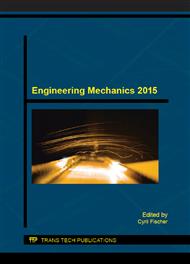[1]
EN 1992-1-1: 2004 Eurocode 2: Design of concrete structures - Part 1-1: General rules and rules for buildings, (2004).
Google Scholar
[2]
ÖNORM B 1992-1-1: 2011 Eurocode 2: Bemessung und Konstruktion von Stahlbeton- und Spannbetontragwerken Teil 1-1: Grundlagen und Anwendungsregeln für den Hochbau, (2011).
DOI: 10.1002/9783433605103.part1
Google Scholar
[3]
Moravčík, M. – Brodňan, M. – Koteš, P. – Kotula, P.: Experience with bridges of the older types of precast (Skúsenosti s mostami zo starších typov prefabrikátov). Betonárske dni 2012, zborník prednášok, STU v Bratislave, 2012, ISBN 978-80-8076-104-2, s. 439-444.
Google Scholar
[4]
Burtscher S.L. - Rinnhofer,G. - Benko,V. - Kollegger,J.: Destructive large-scale tests on highly reinforced spun concrete columns. (Zerstörende Großversuche an hochbewehrten Schleuderbetonstützen). Bauingenieur, Band 78, April 2003, S. 187-193.
Google Scholar
[5]
Fillo, L. - Čuhák, M. - Porubský, T.: Reliability of Asymmetrically Reinforced Columns. In: Concrete and Concrete Structures, Conference Vrátna SK (2013) 387-392.
DOI: 10.1016/j.proeng.2013.09.060
Google Scholar
[6]
KRIŽMA, Martin - PETRŽALA, Jaromír - KIŠAC, Marian. Influence of type of contact of RC beam and strengthening slab on limit states of strengthened element. In Applied mechanics and materials, 2015, vol. 769, pp.294-301.
DOI: 10.4028/www.scientific.net/amm.769.294
Google Scholar
[7]
Stab2D-NL, Pfeiffer, U.: Program: Analysis of reinforced Concrete Structures, TUHH, Version 2. 90, (2014).
Google Scholar
[8]
ATENA, ČERVENKA CONSULTING, Program Documentation ATENA 2D Tutorial $ Manual, Computer Program for Nonlinear Finite Element Analysis of Reinforced Concrete Structures, Revision 2012/07.
Google Scholar
[9]
Paulík, P.: The effect of curing conditions / in situ vs. laboratory / on compressive strength development of high strength concrete. Procedia Engineering Vol. 65: Concrete and Concrete Structures 2013. Conference. Terchová, Slovakia, 23. -25. 10. 2013. s. 113-119. ISSN 1877-7058.
DOI: 10.1016/j.proeng.2013.09.020
Google Scholar
[10]
Gajdošová,K. - Bilčík, J.: Full scale Testing of CFRP – Strengthened Slender Reinforced Concrete Columns. Journal of Composites for Construction ASCE march, April (2013).
DOI: 10.1061/(asce)cc.1943-5614.0000329
Google Scholar


